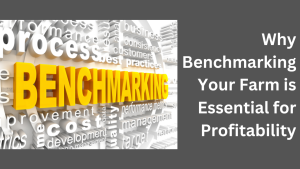Blog
Why Benchmarking Your Farm is Essential for Profitability
21/04/2025
 As a dairy farmer, you work hard every day to keep your farm running efficiently. But how do you really know if you’re making the most of your resources? Are you producing at the same level as other farms in your area? Are your costs in line with the most profitable operators?If you’re not comparing your farm’s performance against similar farms, you could be leaving money on the table. That’s where benchmarking comes in.
As a dairy farmer, you work hard every day to keep your farm running efficiently. But how do you really know if you’re making the most of your resources? Are you producing at the same level as other farms in your area? Are your costs in line with the most profitable operators?If you’re not comparing your farm’s performance against similar farms, you could be leaving money on the table. That’s where benchmarking comes in.
What is Benchmarking and Why Should You Care?
Benchmarking is the process of comparing your farm’s key financial and production figures to other similar farms. It helps you answer important questions like:
By tracking and understanding these numbers, you gain insights into what’s working well and where you can make improvements.
How Does Your Farm Compare?
If recent from dairy farms in your area showed significant differences in profitability between farms. Here are some key figures that might help put your own numbers into perspective:
When you compare your numbers against these benchmarks, it gives you a clear indication of where your farm stands. If you're underperforming in certain areas, small adjustments could lead to significant improvements in profitability.
Benchmarking Will Help You Make Smarter Decisions
1. Identify Cost Savings
Are you spending too much on feed, wages, or maintenance? Benchmarking shows where you can cut unnecessary costs while maintaining production levels.
2. Increase Profitability
By identifying areas of improvement, you can take steps to become more efficient and increase your margins. Even a small reduction in costs per kg of milk solids can add up to thousands in savings.
3. Make Informed Investment Decisions
Thinking about expanding your herd, investing in new equipment, or buying more land? Benchmarking gives you the numbers you need to make confident decisions based on actual data, not guesswork.
4. Improve Financial Planning & Knowledge
Banks would prefer working with farmers who understand their financials. If you can show how your farm compares to industry benchmarks, securing finance becomes much easier.
5. Set Realistic Goals for the Future
Farming success isn’t about working harder; it’s about working smarter. Benchmarking helps you set achievable goals based on real-world data, ensuring you stay on track for long-term success.
Where Do You Start?
If you haven’t benchmarked your farm before, now is the time to start. Here’s how: Gather Your Data – Collect information on your income, expenses, production levels, and assets. Compare Against Industry Benchmarks – Work with a trusted advisor to see how your numbers stack up. Identify Key Areas for Improvement – Focus on the biggest cost drivers and inefficiencies. Track Your Progress Over Time – Regular benchmarking keeps you ahead of financial challenges and helps you continuously improve. Get Expert Help – Book a Free Tax Review If you’re unsure how your farm compares, we can help. At CMK Accountants, we work with dairy farmers to analyse their financials, highlight cost-saving opportunities, and provide strategies to improve profitability.

